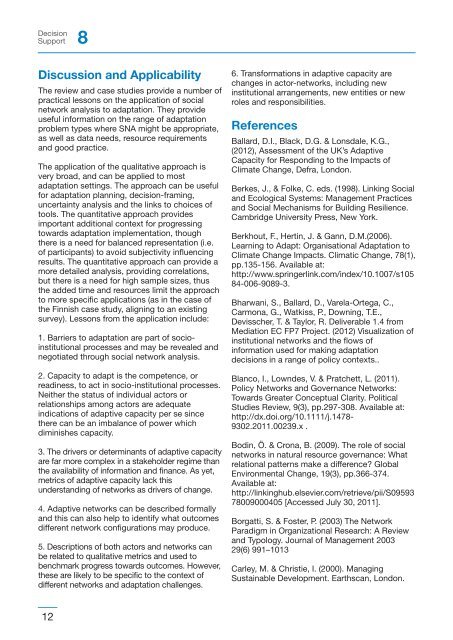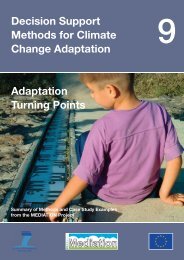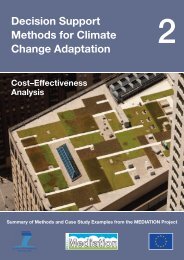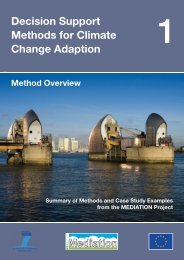Download all Technical Policy Briefing Notes in a single ... - Mediation
Download all Technical Policy Briefing Notes in a single ... - Mediation
Download all Technical Policy Briefing Notes in a single ... - Mediation
- No tags were found...
You also want an ePaper? Increase the reach of your titles
YUMPU automatically turns print PDFs into web optimized ePapers that Google loves.
DecisionSupport 8Discussion and ApplicabilityThe review and case studies provide a number ofpractical lessons on the application of socialnetwork analysis to adaptation. They provideuseful <strong>in</strong>formation on the range of adaptationproblem types where SNA might be appropriate,as well as data needs, resource requirementsand good practice.The application of the qualitative approach isvery broad, and can be applied to mostadaptation sett<strong>in</strong>gs. The approach can be usefulfor adaptation plann<strong>in</strong>g, decision-fram<strong>in</strong>g,uncerta<strong>in</strong>ty analysis and the l<strong>in</strong>ks to choices oftools. The quantitative approach providesimportant additional context for progress<strong>in</strong>gtowards adaptation implementation, thoughthere is a need for balanced representation (i.e.of participants) to avoid subjectivity <strong>in</strong>fluenc<strong>in</strong>gresults. The quantitative approach can provide amore detailed analysis, provid<strong>in</strong>g correlations,but there is a need for high sample sizes, thusthe added time and resources limit the approachto more specific applications (as <strong>in</strong> the case ofthe F<strong>in</strong>nish case study, align<strong>in</strong>g to an exist<strong>in</strong>gsurvey). Lessons from the application <strong>in</strong>clude:1. Barriers to adaptation are part of socio<strong>in</strong>stitutionalprocesses and may be revealed andnegotiated through social network analysis.2. Capacity to adapt is the competence, orread<strong>in</strong>ess, to act <strong>in</strong> socio-<strong>in</strong>stitutional processes.Neither the status of <strong>in</strong>dividual actors orrelationships among actors are adequate<strong>in</strong>dications of adaptive capacity per se s<strong>in</strong>cethere can be an imbalance of power whichdim<strong>in</strong>ishes capacity.3. The drivers or determ<strong>in</strong>ants of adaptive capacityare far more complex <strong>in</strong> a stakeholder regime thanthe availability of <strong>in</strong>formation and f<strong>in</strong>ance. As yet,metrics of adaptive capacity lack thisunderstand<strong>in</strong>g of networks as drivers of change.4. Adaptive networks can be described form<strong>all</strong>yand this can also help to identify what outcomesdifferent network configurations may produce.5. Descriptions of both actors and networks canbe related to qualitative metrics and used tobenchmark progress towards outcomes. However,these are likely to be specific to the context ofdifferent networks and adaptation ch<strong>all</strong>enges.6. Transformations <strong>in</strong> adaptive capacity arechanges <strong>in</strong> actor-networks, <strong>in</strong>clud<strong>in</strong>g new<strong>in</strong>stitutional arrangements, new entities or newroles and responsibilities.ReferencesB<strong>all</strong>ard, D.I., Black, D.G. & Lonsdale, K.G.,(2012), Assessment of the UK’s AdaptiveCapacity for Respond<strong>in</strong>g to the Impacts ofClimate Change, Defra, London.Berkes, J., & Folke, C. eds. (1998). L<strong>in</strong>k<strong>in</strong>g Socialand Ecological Systems: Management Practicesand Social Mechanisms for Build<strong>in</strong>g Resilience.Cambridge University Press, New York.Berkhout, F., Hert<strong>in</strong>, J. & Gann, D.M.(2006).Learn<strong>in</strong>g to Adapt: Organisational Adaptation toClimate Change Impacts. Climatic Change, 78(1),pp.135-156. Available at:http://www.spr<strong>in</strong>gerl<strong>in</strong>k.com/<strong>in</strong>dex/10.1007/s10584-006-9089-3.Bharwani, S., B<strong>all</strong>ard, D., Varela-Ortega, C.,Carmona, G., Watkiss, P., Down<strong>in</strong>g, T.E.,Devisscher, T. & Taylor, R. Deliverable 1.4 from<strong>Mediation</strong> EC FP7 Project. (2012) Visualization of<strong>in</strong>stitutional networks and the flows of<strong>in</strong>formation used for mak<strong>in</strong>g adaptationdecisions <strong>in</strong> a range of policy contexts..Blanco, I., Lowndes, V. & Pratchett, L. (2011).<strong>Policy</strong> Networks and Governance Networks:Towards Greater Conceptual Clarity. PoliticalStudies Review, 9(3), pp.297-308. Available at:http://dx.doi.org/10.1111/j.1478-9302.2011.00239.x .Bod<strong>in</strong>, Ö. & Crona, B. (2009). The role of socialnetworks <strong>in</strong> natural resource governance: Whatrelational patterns make a difference? GlobalEnvironmental Change, 19(3), pp.366-374.Available at:http://l<strong>in</strong>k<strong>in</strong>ghub.elsevier.com/retrieve/pii/S0959378009000405 [Accessed July 30, 2011].Borgatti, S. & Foster, P. (2003) The NetworkParadigm <strong>in</strong> Organizational Research: A Reviewand Typology. Journal of Management 200329(6) 991–1013Carley, M. & Christie, I. (2000). Manag<strong>in</strong>gSusta<strong>in</strong>able Development. Earthscan, London.12





